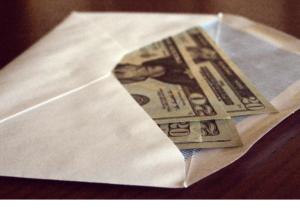Are you taking bribes??
In the FDA-regulated industry, this question has serious implications. We have this vision in our minds of a shadowy figure stepping out of the darkness and slipping an envelope full of money to another person. I recall a report where a car pulled around the back of a building, popped the trunk open, and a person tossed in a large envelope of money – BTW, that was a sting operation.
But I want you to think of the different bribes that can be taken – not just cash. Let me start with a story.
Preparing for bed, I set my alarm for an hour earlier than usual. The plan was to start an exercise routine in the morning. The project was set, the mission was clear…then the alarm went off. As I slowly opened my eyes to look at a predawn room, I hit the “stop” button on the alarm. I had convinced myself that sleep was also important to my health.
It was a bribe…from me to me. A bribe that was easy to take. One that I could argue was valid.
Now, put this concept into the context of our GMP work. We know what we should do. Follow the procedure. Inform the supervisor if the procedure is not correct. Go out to the production floor to observe what is actually happening. Bring in help. The list goes on and on.
But when the pressure mounts to meet a deadline, when the hustle of work is pressing on you, or when you just want to finish work and spend some time on your phone watching videos; that’s when we can take the bribe.
Being in my line of work (Investigator), I’ve interviewed a lot of people – from line clearance personnel to executives. I’m perplexed at some of the reasons that they provide for not being compliant with the GMPs. Don’t get me wrong – some are legitimate. They just didn’t understand what they were doing was incorrect (but this observation leads to one of the Three Sins of GMPs: Lax Supervision). Others, I can see the bribe: it really would not matter anyway; no one would know; I had to save money.
They convinced themselves that an alternative path was valid – even though they “knew” it was not the right one to take. Trust me – it’s easier than you think to go down that “easy” path. And sometimes, the choices are rewarded.
- Cut corners on assay methodology to get results faster – person was featured as a “model” QC analyst for their efficiency.
- Save money on stainless steel piping for a water loop; use PVC piping behind the walls with only stainless steel showing in the production room (gave the impression that the entire system was stainless steel) – person was promoted for ingenuity and saving a lot of money (just prior to the micro issue and leaks in the water system).
- Periodic pest ingress into the warehouse was solved by the use of a BB gun – “way to go” in solving the problem.
- Rodent control in the production area controlled via the company cat – effective and green philosophy.
- Turning off the HVAC system during the evening – excellent way to save on energy expenses.
- Bypass key was inserted into the visual inspection equipment in the “bypass mode” to save on downtime – operations gave congratulations to the maintenance staff for “fixing” their downtime issues.
And there are countless other examples of people not following the procedure, not recording data, etc.
The point here is to always be on guard for the “bribe” of non-compliance. It is covered in various layers of being easier, saving time, and cutting costs. It is tempting to take the bait – just be aware that there is a hook in that approach and it may lead you to the frying pan.

